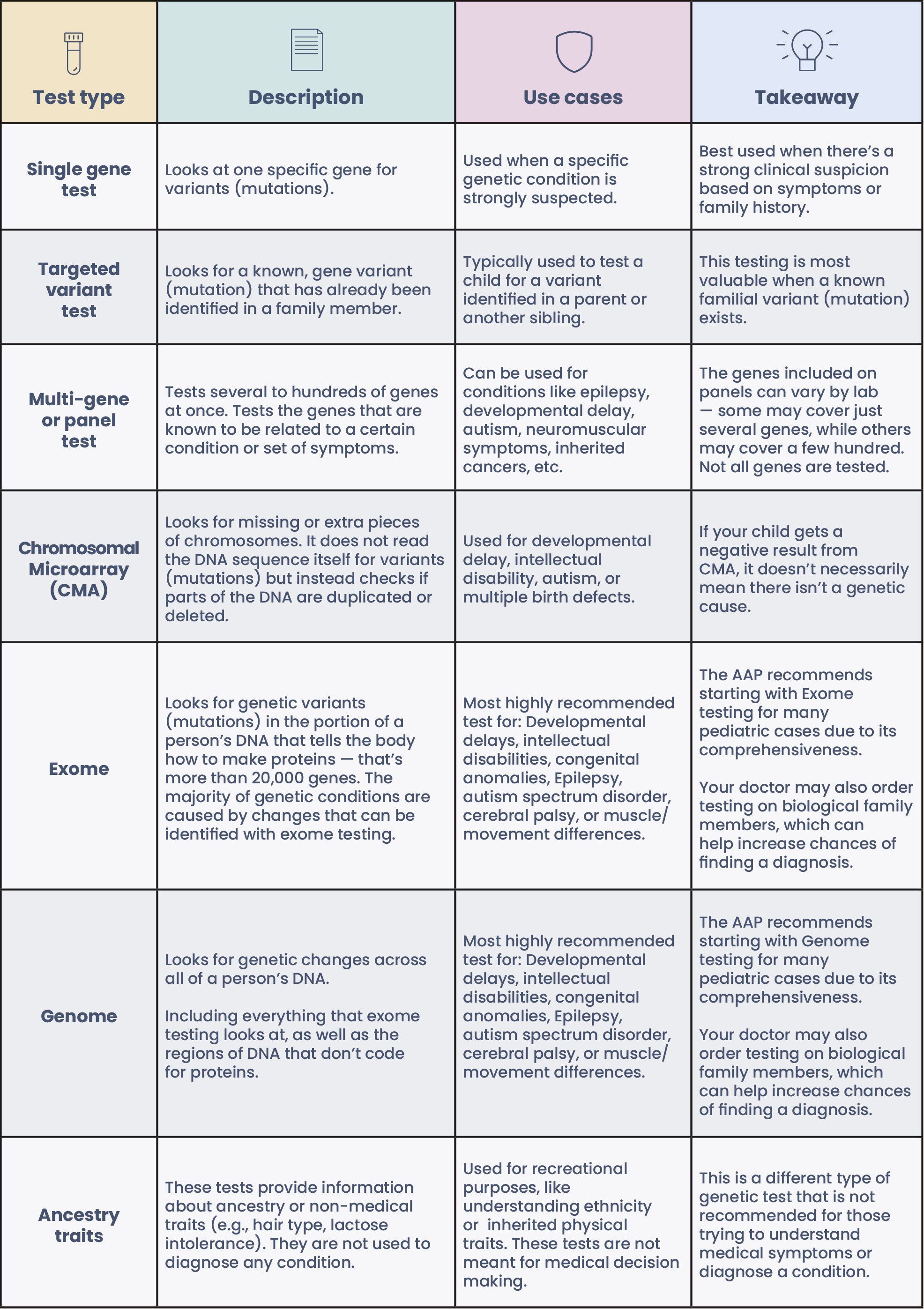Finally—an easy-to-understand guide to pediatric genetic testing.
September 24, 2025 • 5 min read

The moment you start exploring pediatric genetic testing, it’s easy to feel like you’ve entered a never-ending, exhausting maze. There are complex clinical terms, complicated screening guidelines, and conflicting information at every turn. It all makes getting a test feel like an impossible task.

Making matters worse, 50% of individuals with a rare disease have been misdiagnosed.1 It shouldn’t be this hard–when the right test, chosen with care, can change everything. But the fact is that not all tests are created equal. And not every test is right for every family.
Genetic testing for children doesn’t have to be overwhelming. It can be a turning point–opening doors to better treatment options and a new path forward.
Trying to understand terms like exome, panel testing, or genome sequencing? You’re not alone. They’re just different ways of reading a child’s DNA and looking for the cause of a medical condition. Yet they all vary in scope, accuracy, speed, and cost. For example, exome and genome tests look at ~20,000 genes, while other tests may only study a single gene or a few hundred.
Our guide helps you compare different types of genetic tests so you can make the most informed choice for your child. Keep in mind that sometimes the test your doctor recommends may not be the only or best option available.
Recommendations from these organizations can help guide you:
American Association of Pediatrics (AAP)now recommends genetic testing for children with global developmental delay (GDD) and intellectual disabilities (ID).2 That means your child’s pediatrician can now order these genetic tests if they think it’s appropriate.
These new recommendations reflect other medical guidelines: The American College of Medical Genetics and Genomics recommends exome or genome testing as a first-tier test for developmental delay, ID, and congenital anomalies (birth defects),3 and the National Society of Genetic Counselors recommends exome or genome testing for all individuals with unexplained epilepsy–a guideline backed by the American Epilepsy Society.4
For the average family, it takes a child with a rare disease five or more years to get a diagnosis. The cost of that wait? More than $10,000 in unnecessary healthcare costs.5 And the benefits of a diagnosis go far beyond the financial.
An early, accurate diagnosis can give you new insights into your child’s health. It opens the door to more targeted treatments and connected care—replacing confusion with clarity and worry with confidence. For many parents who have to reduce work hours, take time off for appointments, or even quit their jobs to care for their child, getting those answers upfront can lead to fewer appointments, tests, and heartache – improving family health all around.
Some genetic tests now deliver results in as soon as two days, making it possible to move from questions to answers—and from answers to action—faster than ever before. Getting the right test at the right time can mean a world of difference. Not only can a diagnosis change the care journey for your child, it can also transform family health and support.

This chart is only a reference. Be sure to check with your healthcare provider or a genetics specialist for further guidance.
It’s becoming more common for insurance companies to cover genetic testing, but it’s still a good idea to double-check your deductible, co-insurance, and other coverage details based on your child’s symptoms and your plan.

See if your plan is on our list of in-network providers

Need financial assistance Explore your options here.

Managing your child’s epilepsy? See if they qualify for our Epilepsy Partnership Program.
We’re more than a genetic testing company—we’re your guide, your translator, and your advocate. From helping you access the right tests to providing clarity through expert insights, we’re here to make the complex world of genetics feel a little more human.
Our tools and services help make it easier for families to access exome and genome testing. You can talk to your doctor about getting a genetic test or access our telehealth partner directly–from the comfort of your own home. Learn more.
As one parent shared, “The GeneDx test helped save my son’s life.”
That’s the power of a diagnosis. It’s within reach. And we’re here to help you find it.
If you know a family that can benefit from new child health insights and answers, be sure to share this with them, too.
“Trust yourself. All the hoops you have to jump through are hugely time-consuming. But exome testing can make all the difference—and you shouldn’t have to wait years for it. So don’t stop asking.”
-May, mother and caregiver
References: 1. Genetic Alliance UK. Rare Experience 2020. Retrieved March 5, 2025 from https://geneticalliance.org.uk/wp-content/uploads/2024/02/Rare-Experience-2020-Report-updated-May-2…. 2. Rodan LH, et al. Pediatrics. 2025; e2025072219. doi:10.1542/peds.2025-072219. 3. Manickam K, et al. Genet Med. 2021 Nov;23(11):2029-2037. doi: 10.1038/s41436-021-01242-6. Epub 2021 Jul 1. . 4. Smith L, et al. J Genet Couns. 2022 Oct 24. Doi.org/10.1002/jgc4.1646. 5. Soden SE, et al. Sci Transl Med. 2014 Dec 3;6(265):265ra168.